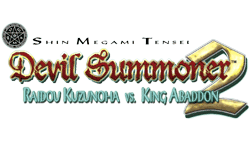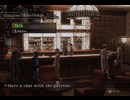|
|

|
PLATFORM
|
PS2
|
BATTLE SYSTEM
|

|
INTERACTION
|

|
ORIGINALITY
|

|
STORY
|

|
MUSIC & SOUND
|

|
VISUALS
|

|
CHALLENGE
|
Hard
|
COMPLETION TIME
|
40-60 Hours
|
|
OVERALL

|
+ Combat/demon capturing can be fun...
- ...but battles take way too long to start...
- ...and there's a spike in difficulty towards the end.
- Terrible direction on how to advance.
- Recycles heavily from first game.
|
Click here for scoring definitions
|
|
|
During the Taisho Era, the people of Japan's Capital take obsession in various fads, among them being luck, with the people finding a great disparity between those with infinite good fortune and those with no luck whatsoever. Meanwhile, a young woman files a missing persons case with the Narumi Detective Agency, with the Devil Summoner Raidou Kuzunoha finding himself on a mysterious trail leading to the mysterious King Abaddon. Atlus's Shin Megami Tensei: Devil Summoner 2: Raidou Kuzunoha vs. King Abaddon picks up where its predecessor left off and builds upon its prequel's action-driven gameplay, although the sequel's various changes aren't always for the better.
Like its predecessor and Shin Megami Tensei: Nocturne, Devil Summoner 2 uses an indicator in enemy-infested areas that changes from yellow to red to indicate how close the player is to encountering enemies; this time, many areas like the streets of the Capital are encounter-free. Most notable throughout the game is the twenty-second-long intervention between encountering an enemy and actually being able to select commands for Raidou's two active monsters to execute, up from one monster in the previous game. Players can choose to have Raidou's monsters automatically execute commands repeatedly, requiring Magnetite, or simply have them execute commands once before normally attacking the enemy.
 Talking with NPCs unfortunately doesn't provide any better direction on how to advance
Talking with NPCs unfortunately doesn't provide any better direction on how to advance
|
|
After selecting initial commands for Raidou's demons, real-time combat begins, with the player able to move Raidou across the battlefield and have him perform various actions. These actions include hacking away at enemies with his sword, executing a special Magnetite-consuming attack, firing his gun at foes, blocking, and even bringing his demons by his side, in which case they become invulnerable to enemies' attacks until Raidou releases them. Additionally, the player can bring up the command menu anytime during battle (unless certain status ailments are affecting Raidou) to do things such as changing demon commands, using items, changing active demons, attempting to escape, and negotiating with the enemy.
Demon negotiation akin to Nocturne replaces the system from the original Devil Summoner, where the player ran up to an enemy and attempted to capture it in one of Raidou's tubes. His active demons can participate in negotiation for better or worse results, and if successful, the player can ask the demon to join Raidou, give an item, or simply leave, with items, money, HP, and Magnetite being necessary for successful negotiation. Once a battle ends, the player gains experience for Raidou and his two active demons, money, and occasional items.
During battle, moreover, for Raidou's demons to exploit the enemy's elemental weaknesses will temporarily stun them, during which time his attacks will recover Magnetite, and which is sometimes necessary for long boss battles since Magnetite can easily run out at times. Outside battle, the player can fuse monsters at the Gouma-Den, where it is also possible to empower Raidou's weapon with special materials occasionally gained from winning fights. During exploration, moreover, Raidou can send his demons on solo investigations, with some having field abilities that are sometimes necessary to advance the game.
 Green explosion
Green explosion
|
|
Luck eventually plays a role in battle, with Raidou able to capture Luck Locusts that occasionally appear in combat using Birdlimes and Insect Cages, consequentially increasing his luck stat. The greater Raidou's luck stat is, the greater chance he has of avoiding encounters with Fiends every New Moon, which can easily decimate him, although it is possible to ward them off by negotiating with them and offering various sacrifices such as the lives of his demons. Enemies can lower Raidou's luck stat occasionally if they gain preemptive strikes against him, with the player able to "purify" him at the Shinoda Shrine to restore his luck to normal.
Overall, the battle system has many things going for it, such as the fun of demon negotiation and fusion, although the shortcomings, such as the somewhat-high encounter rate and the long wait between encountering enemies and actually starting a battle, can really add up over time and bog down the game's already-sluggish pacing. The uncontrollable camera in battle can also blind-sight the player at times, and towards the end of the game there are a few nasty spikes in difficulty that might leave players begging for help on how to advance. Ultimately, combat is fun at first, but can often lose its appeal as the game drags on.
Interaction doesn't fare any better: the controls and menus are decent, although Devil Summoner 2 does an utterly terrible job telling players how to advance the main storyline, and left this reviewer often begging for help on how to advance; that is not something anyone should ever have to do when playing a game. Many parts of the game also require specific types of demons to proceed, and it can certainly be annoying to run around recruiting and fusing demons until players acquire those that are necessary to advance. Overall, this is hardly how interaction should be in an RPG.
Devil Summoner 2 recycles heavily from its predecessor, reusing its action-based battle system with plenty of changes, while featuring the same setting, graphics, and in some cases music, with a few tracks from the first game remixed for the sequel. Still, the sequel is more or less the epitome of derivative.
 Raidou is apparently Hinduist
Raidou is apparently Hinduist
|
|
As with its predecessor, Devil Summoner 2's story is chapter-based, with the theme of luck often playing part. The plot twists and turns throughout the game, although it suffers from the typical convolution of most Japanese RPGs, and the terrible direction on how to advance is an easy mark off the plot. Overall, the plot has some things going for it, although it could have used better direction and focus at times.
The sequel features a jazzy soundtrack similar to its predecessor, fitting the setting and period of the game, and consisting of many remixes of tracks from the first game; however, the music is somewhat repetitive and at times unmemorable. The sound effects are nice, especially the sounds many demons make, and overall, the aurals serve their purpose, if nothing more.
Devil Summoner 2 largely reuses its predecessor's graphics engine, consisting of pre-rendered scenery with three-dimensional character models, although the battle graphics this time are fully 3-D. The character and monster designs look nice, even if they come directly from the previous game, but considering that the game is one of the last on the Playstation 2, it could have certainly looked better, instead looking more like one of the system's first games.
Finally, the game can be somewhat lengthy, about forty to sixty hours, although sidequests such as completing all the Case Files for special rewards can easily boost playing time beyond that range. In the end, Devil Summoner 2 is a somewhat disappointing sequel that starts out strongly at first, although it takes a dive in quality towards the end. The battle system is fun at first, but things such as long loading times before fights can easily bog the game down, along with other negative qualities such as a terrible direction on where to go next and a heavy amount of recycling. Ultimately, this swan song for the Playstation 2 proves to be somewhat off-key.
Review Archives
|









